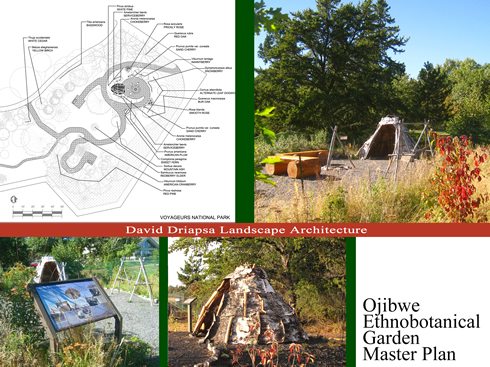
Ojibwe ethnobotanical garden
Voyageurs National Park, Minnesota
U.S. National Park Service
I did the master planning of this project for Voyageurs National Park working with botanist extraordinaire Charles Eckman. This one-acre garden of native plants is adjacent to the Rainy Lake Visitor Center. The planting design restores a site that had been overtaken with invasive exotic plants and revegetated the land with endemic plants. The term ethno-botanical garden refers to the cultural importance and use of these plants to Ojibwe Indians in their traditional life-ways. Ranger led interpretative programs, garden tours, interpretative signage, permanent exhibits and temporary displays along the scenic ADA accessible trail provide information to visitors describing and explaining the cultural use of plants and the native American life-ways in Northern Minnesota.
Native plants are flourishing today where prior to 2010, this site was overrun with a non-native, invasive plant called reed canary grass. The natural beauty was lost in the 1990s during dredging for the boat basin which transported the invasive grass to this location. The prolific exotic plant transformed the formerly bountiful site of native plants into a barren field. Now restored with native vegetation, visitors walk garden paths designed by David Driapsa discover the diversity of nature that is vital to the traditional Ojibwe Indian culture.
During the period from about 1736 through 1941, Native American inhabitants in the park were the Ojibwe. The Bois Forte Band of the Ojibwe occupied a number of small sites during the late nineteenth and early twentieth centuries and at a time when Minnesota Ojibwe Indians were being concentrated on reservations, the Bois Forte continued to live off the land, following their traditional subsistence and religious activities. Despite direct pressures exerted through government Indian policies, water level management, timber cutting, and opening of the area to settlement, the community persevered until the last documented inhabitant moved to the Nett Lake Reservation about 1940. Many of the place names in the park reflect the presence of the Bois Forte Band of the Ojibwe -- Blind Indian Narrows, Big Sky Island, Wigwam Island, Woodenfrog Island, and Nashata Point. Descendants of the bands that once lived in the park, still live at Nett Lake or surrounding communities.
An Ojibwe Indian camp awaits at the heart of the native plant garden. Ojibwe Indians of the region relied on native plants in their daily lives. This garden illustrates the progression of the seasons that brings a succession of plants that Ojibwe people used for food, medicine, ceremonies and raw material. This camp reflects the intimate relationship of the Ojibwe with nature when meals were cooked over an open fire and survival depended on knowledge of the bounty of the earth.
The lodge is referred to as a waaginogaan (wa-gin-o-gaun). The frame of these seasonal homes are fashioned from flexible birch poles tied together with basswood roots and covered with sheets of birch bark. The central fire ring serves for a communal cooking and gathering area hosting meals and ceremonies.
The ADA assessible garden was master planned by David Driapsa and created by Voyageurs National Park with support from the Great Lakes Restoration Initiative; Bois Forte Heritage Center; Voyageurs National Park Association; Friends of Voyageurs National Park; Conservation Corps of America; Boy Scout Troop #145 International Falls High School, Ojibwe Studies Class; Littlefork / Big Falls Junior High English Class; Koochiching County Soil and Water Conservation District; and Voyageurs National Park Staff.